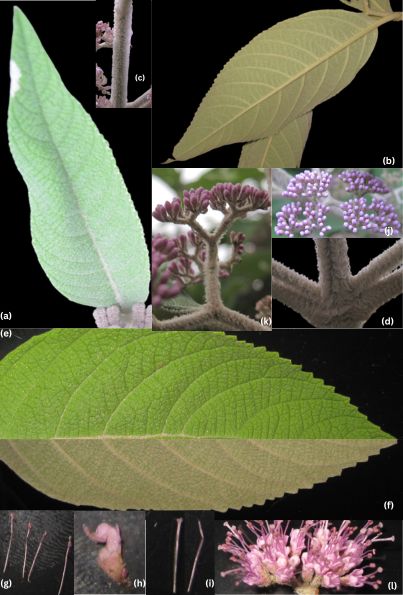Local names: Beng.: Massandari: Hindi: Bastra: Kan.: Ardri; Mal.: Aattathekku: Mar.: Aisar: Tam.: Pandakaiyamaram.
Small tree, 4 – 6 m high; branches and branchlets subterete or obtusely 4-angular; young parts densely yellowish stellate-pubescent; nodes slightly swollen;internodes 4-5 cm long. Leaves broadly ovate or ovate-elliptic, cordate, obtuse or even acute at base, subentire or minutely serrate along margins, acuminate at apex, 15-30 x 8 – 20 cm, subcoriaceous, dark green, rugose, glabrous above, densely stellate-tomentose beneath; lateral nerves 6-9 pairs, ascending, arcuateat margin, distinct beneath; petioles stout, cylindric, 2.5 – 9 cm long, densely, tomentose. Cymes axillary, bipartite or 2-forked; peduncles stout, 1 – 1.5 cm long, densely yellowish pubescent; bracts linear or subulate, ca 4 mm long; pedicels, ca 1 mm long. Calyx cupular, ca 1.5 x 1 mm, obscurely 4-toothed, stellate-pubescent outside. Corolla infundibular, reddish purple or purple, 4-lobed; lobesovate, entire, obtuse, recurved, ca 2 x 1 mm, glabrous; tube narrow, ca 2 x 1mm, ampliate towards apex. Stamens 4, inserted below corolla tube; filaments filiform, exserted, 4 – 6 mm long; anthers oblong, ca 2 x 1 mm, cream-coloured. Ovary globose, ca 1 mm, hirsute; style slender, recurved, 6 – 8 mm long, glabrous; stigma capitate. Drupes globose, 3 – 4 mm, deep purple black when mature, 2 -4-seeded.
Flowering & Fruiting: December – July.
Habitat: Slopes in deciduous, evergreen to semievergreen forests, up to 1400 m. especially towards edges of secondary forests and shola border; uncommon.
Distribution.: INDIA: Goa, Karnataka, Kerala, Maharashtra, Orissa and Tamil
Nadu, Himachal Pradesh.
BANGLADESH, BHUTAN, BURMA, INDONESIA, MALAYSIA, NEPAL.
NEW GUINEA, PHILIPPINE ISLANDS, SRI LANKA and THAILAND
(Moldenke, 1980).
Pollen grains: Spheroidal, diam. 40 um (range 39 – 42 µm). Ectine surface
areolate (Nair & Rehman, I.c.). Chromosome Number: 2n = 130, 136 (Mehra, P.N. & Bawa, K.S. in Evolution 23: 466-481 1969): 2n = 130 (Mehra. P.N. in Nucleus 15: 64-65. 1972).
Uses: Wood suitable for carving. Decoction of the bark used for skin troubles, hepatic obstructions and fever. Leaves boiled in milk are used as a wash for aphthae of the mouth (Ambasta, 1.c.). Specimens examined: GOA: Goa border from Annod, 5.11.1962, R.S. Rao.

Leave a Reply